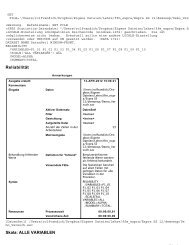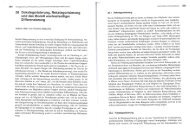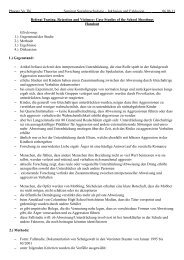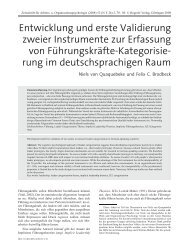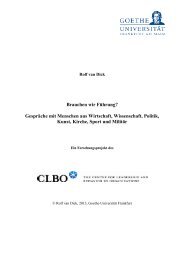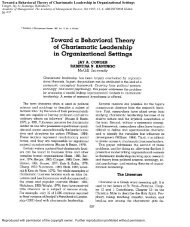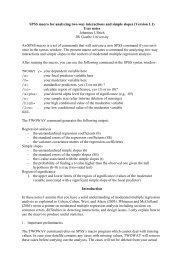Social Identity Theory and Self-categorization Theory: A Historical ...
Social Identity Theory and Self-categorization Theory: A Historical ...
Social Identity Theory and Self-categorization Theory: A Historical ...
You also want an ePaper? Increase the reach of your titles
YUMPU automatically turns print PDFs into web optimized ePapers that Google loves.
<strong>Social</strong> <strong>Identity</strong> <strong>Theory</strong> <strong>and</strong> <strong>Self</strong>-<strong>categorization</strong> <strong>Theory</strong> 207<br />
So why do people favor their own group relative to outgroups? Tajfel<br />
<strong>and</strong> Turner argued that the motivating principle underlying competitive<br />
intergroup behaviour was a desire for a positive <strong>and</strong> secure self-concept.<br />
If we are to accept that people are motivated to have a positive self-concept,<br />
it flows naturally that people should be motivated to think of their groups<br />
as good groups. Furthermore, drawing on Festinger’s writings on social<br />
comparison, it was argued that people evaluate their group with reference<br />
to relevant outgroups. Groups are not isl<strong>and</strong>s; they become psychologically<br />
real only when defined in comparison to other groups. Striving for a positive<br />
social identity, group members are motivated to think <strong>and</strong> act in ways that<br />
achieve or maintain a positive distinctiveness between one’s own group<br />
<strong>and</strong> relevant outgroups. It was this process that was presumed to underpin<br />
real world instances of intergroup differentiation <strong>and</strong> outgroup derogation.<br />
What happens, though, when people belong to a group that has relatively<br />
low status with respect to other groups? <strong>Social</strong> identity theorists spent a<br />
great deal of time outlining how a low status group member can claw<br />
back a positive social identity (Tajfel & Turner, 1979; Turner & Brown,<br />
1978; see also Hogg & Abrams, 1988). Options include leaving the group<br />
(either physically or psychologically), making downward intergroup<br />
comparisons that are more flattering to the ingroup, focusing only on<br />
dimensions that make the ingroup look relatively good, devaluing dimensions<br />
that reflect poorly on the ingroup, <strong>and</strong> engaging in social change to try<br />
to overturn the existing status hierarchy. Which strategy will be chosen<br />
will depend on a range of circumstances, including the extent to which<br />
the boundaries between the group were seen to be permeable, <strong>and</strong> the<br />
extent to which the status differences are perceived to be stable <strong>and</strong>/or<br />
legitimate. In sum, social identity theory was the first social psychological<br />
theory to acknowledge that groups occupy different levels of a hierarchy<br />
of status <strong>and</strong> power, <strong>and</strong> that intergroup behaviour is driven by people’s<br />
ability to be critical of, <strong>and</strong> to see alternatives to, the status quo. For<br />
Tajfel, social identity theory was at its heart a theory of social change. 4<br />
<strong>Self</strong>-<strong>categorization</strong> <strong>Theory</strong><br />
SIT argued that intergroup relations were governed by an interaction of<br />
cognitive, motivational, <strong>and</strong> socio-historical considerations. After Tajfel’s<br />
death in 1982, Turner <strong>and</strong> colleagues sought to elaborate <strong>and</strong> refine the<br />
cognitive element of the theory. In so doing, they aimed to move beyond<br />
the intergroup focus of SIT <strong>and</strong> to comment on intragroup processes as well.<br />
These elaborations were formalized in the book Rediscovering the social group:<br />
A self-<strong>categorization</strong> theory (Turner et al., 1987). The authors argued that the<br />
ideas in this book comprised a new <strong>and</strong> separate theory: self-<strong>categorization</strong><br />
theory (SCT). Having said that, SCT <strong>and</strong> SIT share most of the same<br />
assumptions <strong>and</strong> methods <strong>and</strong> emerge from the same ideological <strong>and</strong><br />
meta-theoretical perspective. In recognition of the similarities between the<br />
© 2008 The Author <strong>Social</strong> <strong>and</strong> Personality Psychology Compass 2/1 (2008): 204–222, 10.1111/j.1751-9004.2007.00066.x<br />
Journal Compilation © 2008 Blackwell Publishing Ltd




